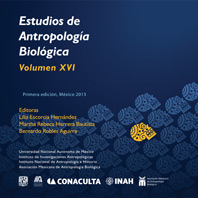Pathological skeletal lesions and selective mortality in the Postclassic population of Cholula
DOI:
https://doi.org/10.22201/iia.14055066p.2013.56677Keywords:
paleopathology, osteological paradox, selective mortality, CholulaAbstract
The skeletal remains pathological lesions are difficult to interpret because of different factors related to the heterogeneity masked and selective mortality (Wood et al. 1992). A new multi-state model (Usher 2000) provides a means to address the selective mortality factor and thus determine the relationship between the presence of pathological lesions in skeletons and the risk of death for a given population. This model was applied to 309 skeletons from the city center Postclassic Prehispanic Cholula. The observations were made by searching cribra orbitalia, porotic hyperostosis, enamel hypoplasias incisors, canines, first and second molars, and proliferative lesions of long bones. While the presence of most of the lesions was associated with an increased risk of death in the town of Cholula, the model indicated that the canine enamel hypoplasias and fibula proliferative lesions had no effect on mortality.
Downloads
Downloads
Published
How to Cite
Issue
Section
License

http://creativecommons.org/licenses/by-nc-nd/4.0/


